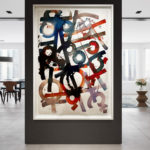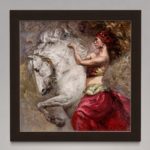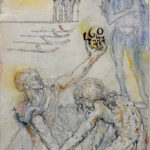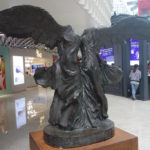“Don’t you guys have any other jackets?” I asked of my friends and crew members Ike and Sam as they lifted a six foot bronze reproduction of Auguste Rodin’s “Eve” into our rented U-Haul. It was around 11pm and a nippy 18 degrees, as we stood in the streets next to the Jacob Javits Center (New York), waiting for help from the Teamsters in moving a group of 12 bronzes from Auguste Rodin and Salvador Dali. While still in Miami, I had reminded Ike and Sam to bring jackets with them to New York as it was going to be winter and quite cold. Instead, both brought matching sport coats. They looked great, although Sam’s was a bit too big for his strong but diminutive frame. Unfortunately, neither jacket provided much warmth to my friends. In fact, my Navy Pea coat (quite possibly the warmest invention ever made) was only marginally warmer as I struggled against gravity to move the pedestals into the truck. To this day I can only imagine how much they wanted to rest and be warm that cold, winter night.
Our exhibition at ART EXPO New York had just closed and I wanted to get out as quickly as possible and head back to my hotel for some much deserved rest before my flight home to Miami. Much to my surprise, the Teamsters are not really that incentivized to help you move any faster than you can probably move yourself. So, the three of us toiled against both the elements and gravity to move the collection of impossibly heavy bronzes, along with several original paintings and pedestals into our rented U-Haul truck they had driven from Miami to New York. Exhibitions are truly the glamorous side of the art world.
While the show itself was successful and fun, exhibitions themselves are a fantastic amount of work, particularly when you are in a foreign town and dealing with unfamiliar practices, labor, buyers, personalities and otherwise. However, dealing with unforeseen circumstances and idiosyncratic places was part and parcel of our trade. Further, it allowed me to become acclimatized to the formation and curation of large exhibits, the arrangements of setting up large groups of artworks into a small space (in this case, roughly 20 feet by 10 feet) the meeting of clients in faraway places and the unpredictability of massive exhibits. What it also did was to prepare me to make certain I never pass up the opportunity to visit another exhibition that might yield either art to sell and/or clientele to sell it to.
Here we are nearly a decade later on a boat headed from Venice airport on the mainland of Italy to the island of Venice itself. My wife Kat and I are here to meet with several colleagues at an exhibit of their wares in the magical and fantastical city on the water. Not truly knowing what to expect between conceptual installations and salable work, we contented ourselves with knowing that, at a minimum, we would be visiting friends in a wonderful place. The city is indeed spectacular. As an interior designer, Kat often mentioned that clients in the US pay an arm and a leg for Venetian plaster which is literally what you see on the street in Venice. What they tend to think of a detritus, we value implicitly.

After our late check-in, a few glasses of wine by the canal and a restful night’s sleep, we awoke the following morning and made our way South through the famously winding labyrinth of streets known as Venice. If you have never been to Venice, it is a city where everything is accentuated tenfold. The day is brighter and the night is darker. The wine more potent and the music more dramatic. The colors more bold… And the floors stickier. It is the city of love simply because if one emotion is more concentrated… it serves that they all are. The streets are a winding maze of ancient pathways. One imagines the city as it once was in its heyday. Once the walls of this city stood smooth and colorful. Now they stand as an intricate crumble of rock and resin giving the entire city a texture unlike elsewhere in Europe. We found ourselves at the southwestern most point of the island at the 54th Annual Venice Bienalle checking in to the “ILLUMinations” (ILLUMINazioni) exhibition. The sheer size and scope of the exhibit made my think back on the many exhibitions I have been a part of, both with Ike and Sam and without. The space was immense and there was artwork everywhere. After a few choice conversations and introductions we began our trek through the main portion of the exhibitions. The main display featured nearly 85 artists, and throughout Venice nearly 90 countries have individual exhibition halls featuring conceptual works generally by one artist or artist consortium. All this is directed by the inimitable Bice Curiger and organized by la Biennale di Venezia, chaired by Paolo Baratta. 32 of the artists featured are young or emerging artists born after 1975. As an art merchant, many of these individual exhibits serve to stimulate conversation but do not inspire us as a items of salable merchandise which I can expose my clients to. “Art pour l’art” (Art for Art’s sake) is the melding of ideas with form. This does not necessarily translate for a merchant, but can certainly inspire creative though and artistic reflection.
One of the first exhibits we entered featured a group of televisions with crystals taped to the screen, surrounded my aluminum foil appendages and zeroxed photos of the atrocities of war. Mangled faces and bloodied corpses draped over cardboard tubes with duct tape. While intriguing and thought-provoking, it did little to sate my interests in commercial pursuits. Indeed, perhaps my indifference to such statements makes me precisely the nihilistic force the artist was rebelling against.
What I was searching for was something unique. Something I would not find in my small corner of the world. Something… other.
Throughout the exhibition, I saw fantastic examples of visual and conceptual stimuli, some of which made Kat and I giggle to ourselves, others which I felt were fantastic, salable expressions of artistic genius. We watched Art film after art film of varying viability and quality. In one, a conglomeration of scenes by American Christian Marclay (American, b. 1955) entitled “The Clock” (2010) the pivotal hour was 12 o’clock was precisely timed to chime at the hour of noon. The work itself runs on 24 hours cycles and keeps the time precisely. Gongs of Frederick March’s “Hunchback of Notre Dame” clanged alongside cuckoo clocks, Marty McFly, Leonardo DiCaprio, Luis Bunuel and Salvador Dali’s “Un Chien Dalou”, car alarms, buzzers, Gary Cooper and every manner of watch. When I looked at my own watch, indeed it was 12 noon. This film won the Golden Lion for Best Artist during the exhibition… for good reason. You often do not think about how much time is an effect in movies and television, even though Jack Bauer (24) seemed to make a cottage industry of it in recent years. Moving on, some of my favorite works in the exhibition made use of antique etchings blown up to scale and placed behind variable styles of glass to create a stereoscopic effect by the late Sigmar Polke (1941-2010). This play on old/new was an interesting set device, particularly considering the setting, Ancient Venice in a modern exhibition hall. I also enjoyed the iconic imagery overpainted by cartoon of disturbing effects by Llyn Foulkes (below).
Kat tended to like the massive image of Jesus made entirely of painted Easter Eggs by Ukrainian artist Oksana Mas and the oversized Rorschach images by Christopher Wool (American, b. 1955). We both found the taxidermized birds sitting on steel bars near the ceiling to be fun and slightly disturbing (I had already had a run-in with an angry bird with fiber regularity issues on this trip)
The highlight of the exhibition were three works from Tintoretto loaned for Biennale from the board of Venetian Museums, including the “Last Supper” from san Giorgio Maggiore Basilica. As noted by Bice Curiger (Director of ILLUMinations at the 54th International Art Exhibition) “Tintoretto’s art is unorthodox and experimental, distinguished by dramatic lighting. The inclusion of these paintings in the Biennale is founded on the conviction that, with their visual and expressive directness, they still possess the power to engage a contemporary audience.” Although we were unable to take photos of the works, they were breathtaking and an honor to behold.

From there, we were led to a second portion of the exhibition in Arsenale (above), and abandoned railway station used by the armies of Italy to transport troops, supplies, arms, foods, etc. into and out of Venice. The building was fascinating and made me dream of exhibiting my own inventories there. The rich history and varied textural surfaces between exposed brick and crumbling Venetian plaster created an environment that contrasted with the clean, polished artworks cradled within. I imagined the oversized works of Daniel Bilodeau, Bask and Sharon Raoli alongside the sculptures of dEmo, Boban and Richard MacDonald in the space.
It was in the Arsenale that I saw my favorite work in the entire exhibition, a full-scale reproduction of Giambologna’s “Rape of the Sabine Women” made completed from wax and slowly destroying itself. The entire composition was a candle, slowly burning itself to the ground by Swiss artist Urs Fischer. In front, a figure stood silently burning whilst watching the conflagration. After months of exhibition and constant burning, the “Rape” still stood nearly one and a half meters high and the watching figure’s face sat staring from the floor instead of on the figure himself. While heartbreaking for me to imagine the months of tortuous work it took to sculpt and the backbreaking labor to move these works into place, they stood as a wonderful allegory about the impermanence of all things. Fischer’s works were poignant, impressive and the certainly the highlight of the exhibit for me.
Reading the forgoing, I realize that all art is subjective and that the types of works I lean toward are a specific genre all of which is geared toward my own commercial interests. I get it. The condemnation of the jilted artist is nothing new for someone in my trade. Every artist feels that their statements are the most valid and their work is the most beautiful. So does every dealer. We specialize in what we enjoy just as every artist does. And to each his/her own.
It is my hope that more exhibitions will follow and more works remain to be discovered on our travels. Perhaps down the road, Ike, Sam and I will have more adventures moving weighty bronzes on a dark and cold New York evening. Perhaps, we will just relax, have a cup of coffee and allow the Teamsters do it. Perhaps.
YOUTUBE VIDEO:
Venice Biennale- Starring Reed, Kat & Venice













